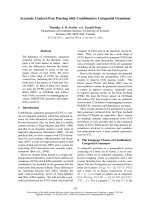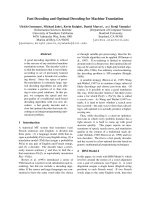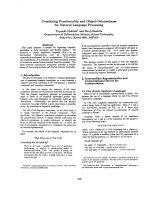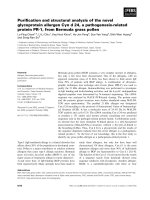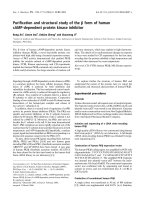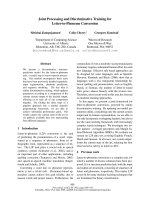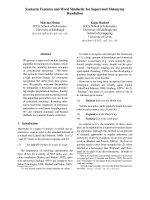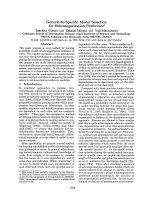Báo cáo khoa học: "PROOF FIGURES AND STRUCTURAL OPERATORS FOR CATEGORIAL GRAMMAR" pot
Bạn đang xem bản rút gọn của tài liệu. Xem và tải ngay bản đầy đủ của tài liệu tại đây (501.49 KB, 6 trang )
PROOF FIGURES AND STRUCTURAL OPERATORS
FOR CATEGORIAL GRAMMAR"
Guy Barry, Mark Hepple t, Nell Leslie and Glyn Morrill I
Centre for Cognitive Science, University of Edinburgh
2 Buccleuch Place, Edinburgh EBB 9LW, Scotland
guy@cogsci,
ed. ac.uk, arh@cl, cam. ac. uk,
neil@cogs c i. ed. ac. uk, Glyn. Norrill@let. ruu. nl
ABSTRACT
Use of Lambek's (1958) categorial grammar for lin-
guistic work has generally been rather limited. There
appear to be two main reasons for this: the nota-
tions most commonly used can sometimes obscure the
structure of proofs and fail to clearly convey linguistic
structure, and the cMculus as it stands is apparently
not powerful enough to describe many phenomena en-
countered in natural language.
In this paper we suggest ways of dealing with both
these deficiencies. Firstly, we reformulate Lambek's
system using proof figures based on the 'natural de-
duction' notation commonly used for derivations in
logic, and discuss some of the related proof-theory.
Natural deduction is generally regarded as the most
economical and comprehensible system for working
on proofs by hand, and we suggest that the same
advantages hold for a similar presentation of cate-
gorial derivations. Secondly, we introduce devices
called
structural modalities,
based on the structural
rules found in logic, for the characterization of com-
mutation, iteration and optionality. This permits the
description of linguistic phenomena which Lambek's
system does not capture with the desired sensitivity
and
gencrallty.
LAMBEK CATEGORIAL
GRAMMAR
PRELIMINARIES
Categorial grammar is an approach to language de-
scription in which the combination of expressions is
governed not by specific linguistic rules but by general
logical inference mechanisms. The point of departure
can be seen as Frege's position that there are certain
'complete expressions' which are the primary bear-
ers of meaning, and that the meanings of 'incomplete
expressions' (including words) are derivative, being
* We would like to thank Robin Cooper, Martin Picker-
ing and Pete Whitelock for comments and discussion relat-
ing to this work. The authors were respectively supported
by SERC Research Studentship 883069"/1; ESRO Re-
search Studentshlp C00428722003; ESPRIT Project 393
and Cognitive Science/HCI Research Initiative 89/CS01
and 89/CS25; SERC Postdoctoral Fellowship B/ITF/206.
I Now at University of Cambridge Computer Labora-
tory, New Musctuns Sitc, Pembroke Street, Cambridge
(31}2 3Q(;, Engl~u.l.
1 Now at OTS, ']'rans 1O, 3512 JK Utrecht, Netherlands.
their contribution to the meanings of the expressions
in which they occur. We s.uppese that linguistic ob-
jects have (at least) two components, form (syntactic)
and meaning (semantic). We refer to sets of such ob-
jects as
categories,
which axe indexed by
types,
and
stipulate that all complete expressions belong to cat-
egories indexed by
primitive types.
We then recur-
sively classify incomplete expressions according to the
meems by which they combine (syntactically and se-
mantically) with other expressions.
In the 'syntactic calculus' of Lambek (1958) (var-
iously known as
Lambek categoriai grammar, Lambek
calculus,
or L), expressions are classified by means of
a set of
bidirectional types as
defined in (1).
(1) a. If X is a primitive type then X is a type.
b. If X and Y are types then
X/Y
and
Y\X
are types.
X/Y
(resp.
Y\X) is
the type of incomplete expres-
sions that syntactically combine with a following (resp.
preceding) expression of type Y to form an expression
of type X, and semantically are functions from mean-
ings of type Y to meanings of type X.
Let us assume complete expressions to be sen-
tences (indexed by the primitive type S), noun phrases
(NP), common nouns (N), and non-finite verb phrases
(VP). By the above definitions, we may assign types
to words as follows:
(2) John, Mary, Suzy := NP
man, paper := N
the := NP/N
likes, read := (NP\S)/NP
quickly : (NP\S)\(NP\S)
without := ((NP\S)\(NP\S))/VP
understanding := VP/NP
We represent the form of a word by printing it in
italics, and its meaning by the same word in boldface.
For instance, the form of the word "man ~ will be
represented as
man
and its meaning as man.
PROOF FIGURES
We shall present the rules of L by means of
proo~
fi~res, based on Prawitz' (1965) systems of 'nat-
ural deduction'. Natural deduction was developed
by Gentzen (1936) to reflect the natural process of
mathematical reasoning in which one uses a number
of
in/erence tulsa
to justify a single proposition, the
conclusion,
on the basis of having justifications of a
number of propositions, called
assumptions.
During
- 198 -
a proof one may
temporarily
make a new assumption
if one of the rules licenses the subsequent withdrawal
of this assumption. The rule is said to
discharge
the
assumption. The conclusion is said to
depend
on the
undischarged assumptions, which are called the
by.
potheses
of the proof.
A proof is usually represented as a tree: with the
assumptions as leaves and the conclusion at:the root.
Finding a proof is then seen as the task of filling this
tree in, and the inference rules as operations on the
partially completed tree. One can write the infer-
ence rules out as such operations, but as these are
rather unwieldy it is more usual to present the rules
in a more compact form as operations from a set of
subproofs (the
premises)
to a conclusion, as follows
(where m >_ I and n >_ 0):
(3) . : [Y.l] d , [y.n] d
.R'
Z
This states that a proof of Z can be obtained from
proofs of X1 ,
Xm
by discharging appropriate oc-
currences of assumptions Y, I/,. The use of
square brackets around an assumption indicates its
discharge. R is the name of the rule, and the index i
is included to disambiguate proofs, since there may be
an uncertainty as to which rule has discharged which
assumption.
As propositions are represented by formulas in
logic, so linguistic categories are represented by type
formulas in L. The left-to-right order of types indi-
cates tim order in which the forms of subexpressions
are to be concatenated to give a composite expres-
sion derived by the proof. Thus we must take note
of the order and place of occurrence of the premises
of the rules in the proof figures for L. There is also
a problem with the presentation of the rules in the
compact notation as some of the rules will be written
us if
they had a number of conclusions, as follows:
(4) :
Xl X,~
,,, /r~
~q Y.
This rule should be seen as a shorthand for:
(,~) : :
Xl Xm
tt
Y,
Y
Z
If the rules are viewed in this way it will be seen that
they do not violate the single conclusion nature of the
figures.
As with standard natural deduction, for each con-
nective there is an
elimination
rule which gates how
a type containing that connective may be consumed,
and an
introduction
rule which states how a type con-
raining that connective may be derived. The elimi-
nation rule for / states that a proof of type
X/Y
followed by a proof of type Y yields a proof of type
X.
Similarly the elimination rule for \ states that
a proof of type
Y\X
preceded by a proof of type Y
yields a proof of: type X. Using the notation above,
we may write these rules as follows:
: : b. i:. .
(6) a.
x)r., i'le v\x\~
X X
We shall give a semantics for this calculus in the same
style as the traditional functional semantics for intu-
itionistic logic (Troelstra 1969; Howard 1980). In the
two rules above, the meaning of the composite expres-
sion (of type X) is given by the functional application
of the meaning Of the
functor
expression (i.e. the one
of type
X/Y
or
Y\X)
to the meaning of the
argument
expression (i.e. the one of type Y). We represent func-
tion application :by juxtaposition, so that likes John
means likes applied to John.
Using the rules [E and \E, we may derive "Mary
likes John" as a sentence as follows:
(7) Mary likes John
(NP\S)/NP NP
/P.
,i
NP NP\S
S
The meaning of the sentence is read off the proof by
interpreting the/E and \E inferences as function ap-
plication, giving the following:
(8) (likes John) Mary
The introduction rule for / states that where the
rightmost a~sumption in a proof of the type X is of
type Y, that assumption may be discharged to give
a proof of the type
X/Y.
Similarly, the introduction
rule for \ states that where the leftmost assumption
in a proof of the type X is of type Y, that assumption
may be discharged to give a proof of the type
Y\X.
Using the notation above, we may write these rules
as follows:
(9) a. ~]' b. [v.]'
.~1I, v\x \X ~
Note however that this notation does not embody the
conditions that ihave been stated, namely that in/I
Y is the rightmost undischarged assumption in the
proof of X, and:in \I Y is the leftmost undischarged
assumption in the proof of X. In addition, L carries
the condition that in both/I and \I the sole assump-
tion in a proof cannot be withdrawn, so that no types
are assigned to the empty string.
In the introduction rules, the meaning of the re-
sult is given by lambd&-abstraction over the meaning
of the discharged assumption, which can be repre-
sented by a variable of the appropriate type. The re-
lationship between lambda-abstraction and function
application is given by the law of
t-equality
in (10),
- 199 -
where c~[/~lV ] means '~ with//substituted for #'. (See
llindley and Seldin 1986 for a full exposition of the
typed lambda-calculus.)
(10)
(xv[o,])//= o,[//Iv]
Since exactly one assumption must be withdrawn, the
resulting lambda-terms have the property that each
binder binds exactly one variable occurrence; we refer
to this as the 'single-bind' property (van Benthem
1983). The rules in (9) are analogous to the usual
natural deduction rule of
conditionalization,
except
that the latter allows withdrawal of any number of
assumptions, in any position.
The ]I and \l rules are commonly used in con-
structions that are assumed in other theories to in-
volve 'empty categories', such as (11):
(11) (John is the man) who Mary likes.
We assume that the relative clause modifies the noun
"man" and hence should receive the type N\N. The
string "Mary likes" can be derived as of type S/NP,
and so assignment of the type (N\N)/(S/NP) to the
object relative pronoun "who" allows the analysis in
(12) (cf. Ades and Steedma n 1982):
(12) who
Mary
likes
(NP\S)/NP [NP]aIE
NP ' NP\S\E
S
(N\N)I(S/NP) SINP III
./F.
N\N
The meaning of the string can be read off the proof by
interpreting /I and \I as lambda-abstraction, giving
the term in (13):
(is) who (Ax[(likes ~) Mary])
Note
that
this mechanism is only powerful enough
to allow constructions where the extraction site is
clause-peripheral; for non-peripheyad extraction (and
multiple extraction) we appear to need an extended
logic, as described later.
DERIVATIONAL EQUIVALENCE AND
NORMAL FORMS
In the above system it is possible to give more than
one proof for a single reading of a string. For exam-
pie, corot)are the derivation of "Mary likes John" in
(7), and the corresponding lambda-term in (8), with
the derivation in (14) and the iambda-term in (15):
(14) Mary likes Jolm
(NP\S)/NP [NPp
NP NP\S\E /E
S
S/NP/I1 NP
.i~,
S
(15) (Az[(likcs x) Mary]) John
By the definition in (10), the terms in (8) and (15) are
//-equal, and thus have the same meaning; the proofs
in (7) and (14) are said to exhibit
derivationai equiva-
lence.
The relation of derivational equivalence clearly
divides the set of proofs into equivalence classes. We
shall define a notion of
normal form
for proofs (and
their corresponding terms) in such a way that each
equivalence class of proofs contains a unique normal
form (cf. Hepple mad Morrill 1989).
We first define the notions of
contraction
and
re.due.
tion.
A contraction schema R D C consists of a par-
ticular pattern R within proofs or terms (the
redez)
and an equal and simpler pattern C (the
contractum).
A reduction consists of a series of contractions, each
replacing an occurrence of a redex by its contractum.
A normal form is then a proof or term on which no
contractions are possible.
We define the following contraction schemas:
weak
contraction
in (16) for proofs, and
t-contraction
in
(17) for the corresponding lambda-terms.
(16) ~. V.]'
" I> Y
v
,/v,
~"
X
b.
[r.),
:
X i l>
~, v\x \I
XV. k
X
(17) (~y[,~]),o ~ ~,Laly]
From (10) we see that t-contraction preserves mean-
ing according to the standard functional interpreta-
tion of typed lambda.calculus. Therefore the cor-
responding weak contraction preserves the semantic
functional interpretation of the proof; in addition it
preserves the syntactic string interpretation since the
redex and contractum contain the same leaves in the
same order. For example, the proof in (14) weakly
contracts to theproof in (7), and correspondingly the
term in (15) //-contracts to the term in (8). The
results of these contractions cannot be further con-
tracted and so ~re the respective results of reduction
to
weak normal form
and//.normal
form.
Weak contraction in L strictly decreases the size
of proofs (e.g. the number of symbols in a contractum
is always less than that in a redex), and//-contraction
in. the single-bind lambda-calculus strictly decreases
the size of terms. Thus there is
strong normalization
with respect to these reductions: every proof (term)
reduces to a weak normal form (//-normal form) in
a finite number of steps. This has as a corollary
(normalization)
that every proof (term) has a nor-
mad form, so that normal forms are
fully
represen-
tative: every proof (term) is equal to one in normal
form. Since reductions preserve interpretations, an
interpretation of a normal form will always be the
- 200 -
same as that of the original proof (term). Thus re-
stricting the search to just such proofs addresses the
problem of derivational equivalence, while preserving
generality in that all interpretations are found•
Proofs in L and singie-bind lambda-terms (like
the more general cases of intuitionistic proofs and full
lambda-terms) exhibit a property called the Church-
Itosser property) from which it follows that normal
forms are unique. 2
For formulations of L that are oriented to pars-
ing, defining normal forms for proofs provides a basis
for handling the so-called 'spurious ambiguity' prob-
lem, by providing for parsing methods which return
all aml only normal form proofs.
See
KSnig (1989)
~t,,d
lh:pl,lc
(1990).
STRUCTURAL MODALITIES
From a logical perspective, L can be seen as the weak-
est of a hierarchy of implicational sequent logics which
differ in the amount of freedom allowed in' the use
of assumptions. The higl,est of these is (the impli-
cational fragment of) the logistic calculus LJ intro-
duced in Gentzen (1936). Gentzen formulated this
calculus ia terms of sequences of propositions, and
then provided explicit structural rules to show the
permitted ways to manipulate these sequences. The
structural rules are permutation, which allows the or-
der of the assumptions to be changed; contraction,
which allows an assumption to be used more than
once; and toeakening, which allows an assumption to
be ignored. For a discussion of the logics generated
by dropping some or all of these structural rules see
e.g. van Benthem (1987).
Although freely applying structural rules 'are clear-
ly not appropriate in categorial grammars for linguis-
tic description, commutable, iterable and optional el-
eme,ts do occur in natural language. This suggests
that we should have a way to indicate that structural
operatiops are permissible on specific types, while still
forbidding tl,eir general application. To achieve this
we propose to follow the precedent of the e~ponen-
lial operators of Girard's (1987) linear sequent logic,
which lacks the rules of contraction and weakening,
by s.ggesting a similar system of operators called
structnral sodalities, tiers we shall describe a sys-
tem of universal sodalities, which allow us to deal
with the logic of commutable, iterable and: optional
extractions, a
For each universal sodality we shall present an
elimination rule, and one or more 'operational rules',
whicl, are essentially controlled versions of structural
1 This is the property that if a proof (term) M reduces
to two proofs (terms) NI, N2, then there is a proof (term)
to wlfich both NI and N2 reduce.
2The above remarks also extend to a second form of re-
duction, strong reduction/11-reduction, which we have not
space to describe here. See Morrill et aL (1990).
aThe name is dmseJa because the elimination and in-
troduct;on rules appropriate to each operator turn out to
be those for the unlvcrsal ,nodality in the ]nodal logic $4.
See Dosen (1990),
rules. (Introduction rules can also be defined, but we
omit these here for brevity and because they axe not
required for the linguistic applications we discuss.)
Note that these operators are strictly formal devices
and not geared towards specific linguistic phenom-
ena. Their use fat the applications described, which
are suggested purely for illustration, may lead to over-
generation in some cases. 4
COMMUTATION
The type AX is assigned to an item of type X which
may be freely permuted. A hu the following infer-
ence rules:
: : : •
(18) ,~'x ~x
~" ~"
~x
' ~E ~-~Prm Prn~
X Y Z~X AX Y
From these rules we see that an occurrence of an item
of type X in any position may be derived from an item
of type AX.
We may use this operator in a treatment of rein.
tivization that will allow not only peripheral extrac-
tion as in (198), but also non-peripheral extraction as
in (19b):
(19) a. (Here is the paper) which Snzy read.
b. (Here is the paper) which Suzy read
quickly.
We shall generate these examples by assuming that
"which z licenses extraction from any position in the
body of the relative clause. We may accomplish this
by giving Uwhich~ the type (N\N)/(S/ANP) (cf. the
extraction operator T of Moortgat (1988)). This al-
lows the derivations in (20a-b) (see Figure 1), which
correspond to the lambda-terms in (21a-b) respec-
tively:
(21) a. which (Az[(read z) Suzy])
b. which (Az[(qulckly (read z)) Suzy])
ITERATION
The type X ~ is assigned to an item of type X which
may be freely permuted and iterated, t has the fol-
lowing inference rules:
• . .
• JE xtTPrm Prm I
X Y X t Y
f Con
X t X t
'In Morrill et 4/. (1990) we give a system of wodali-
ties that differs from the present proposal in several re-
spects. There aretwo unidirectional commutation modal.
itiea rathe¢ than the single bidirectional sodality given
here, and a single operational rule is associated with each
of the universal modalities. We ahto suggest a (more ten-
tative) system of swlstenfial modalltles for dealinl$ with
elements that are themselves commutable, iterable or
optional.
- 201 -
(2o)
which Suzy
(N\N)/(S/ANP)
NP
N\N
l).
wldch Suzy read
NP
(N\N)/(S/~NP)
N\N
"
re~d
(NP\S)/NP NP
• /E
NP\Sw.
S
, ,/F
S/&NP
./E
(NP\S)/NP
NP\S
quickly
(NP\S)\(NP\S)
[~NP]I PrmLX
~NP (NP\S)\(NP\S)
&E
NP
"/E
NP\S\E
S
S/ANP/I'
-/E
\E
(24)
wlfich
Suzy
read
(N\N)/(S/NP)')
NP
N\N
(NP\S)/NP
without
((NP\S)\(NP\S))/VP
NP\S
(NP\S)\(NP\S)
Np t
'E
NP
/~.
S
S/NP1111
.IE
understanding
VP/NP
VP
NP\S.\ E
[NP~p
! Con
Np I Np t
'E
NP
,/E
./E
Prm t
(NP\S)\(NP\S)
\E
(2s)
too long
PredP/(ForP/NPII)
for Suzy to concentrate
(ForP/VP)/NP
NP
./F,
ForP/VP VP
,/E
ForP
PredP
ForP
, ,/P
ForP/NP u
/E
[NP II] I
Wknll
Figure 1. Derivations illustrating use of structural modalities
- 202-
One or more occurrences of items of type X in any
position may be derived from an item of type X ~.
We may use this modality in t treatment of mul-
tiple
¢xtraction. Consider tits parasitic gap construc-
tion in (23):
(23) (Here is the paper) which Susy read without
understanding.
In order to generate both this example and the ones
iu (19), we shall now assume that ~which" licenses
extraction not just from any position in the body of
a relative clause, but from any number of positions
greater than or squad to one. We may do this by al-
tering the type of awhich ~ to (N\N)/(S/NPt). Since
h~s
'all
the inference rules of A, tl~e derivations in
(20) v~iil still go througl, with the new type. In addi-
tion~ the icon inference ~ule allows the derivation of
(23)
given in (24) (see Figure 1), and the correspond-
i,g term in (25/:
(25.) which (Az[((without (understanding z))
(read z)) Suzy])
OPTIONALITY
The type X II is assigned to an item of typeX which
may be freely permuted, iterated and omitted. I has
the following inference rules:
Prm
X ~" '~ 'X n
xll Y Y
Zero or more occurrences of items of type X in any
position may be derived from an item of type X ~[.
We n|ay use this modality in a treatment of op
tional extraction, ors illustrated by (27):
(27) a. (The paper was) ago long for Sezy to read.
b. (The paper was) too long for Susy to read
quickly.
c. (The paper was) too long for Suzy to read
witlmut understanding.
d. (The paper was) too long for Suzy to con-
centrate.
We shall ~ssume for simplicity that ato~-infinitives
are single lexical item~ of typ~ Vp, that ~for-to" clauses
have a special atomic type ForP (so that Yfor ~ has
the type (ForP/VP)/NP), and that predicate phrases
have a special atomic type PredP. Given these assign-
ments, the type PredP/(ForP/NP:) for "too long s
would allow (27a-c), but not (27d). In order to gener-
al.e
all four examples, we shall a~sume that %00 long ~
liceuses extraction from any number of positions in
the embedded cl/xuse greater than or equal to zero,
aud thus give it the type PredP/(PorP/NPIl I. Again,
g
has all the inference r~les of I generating
(2?a-c),
and the Wkn It rule allows (27d) to be derived as in
(28) (see Figure
1),
giviug theterm in (291:
(29) too-long (Az[fo~ (to-concentrate SuzYl] I
CONCLUSIONS
We have introduced a scheme of p~oof figure~ for Lam-
bek c~tegorial gr~mmax in the style of ~atural de.
duction, and proposed structural modalities which we
suggest axe
suitable for the capture of linguistic sen.
eralisations. It zemxins to extend the ~em~mtic treat-
ment of the structural moda]ities,, to refine the proof
theory, and hence to develo p more efficient parsing at,
gorithms. For the p~eae~t, we. hope that the proposal~
made can be seen as gaining linguistic practicaJity in
the c~tegoria~ description of ~atural Iq~gu~ge, with-
out losing mathematical elegance.
REFERENCES
AdeJ, A.E. and Steedman, M.J, (1982). On the order
of words. Lingwiatice and philomoph~ 4,
517-~58.
van Benthem,
J. (1983).
The semantics 0] varietv in
categorial grammar. Report 83-29, Del~rtment of Math-
ematics, Simon Fraser Unlvemity. Also in W. Buszkowski,
W.
Marciszewsld and J. van Benthem (eds), Categorial
Grammar, Volume 25, Linguistic & Literary SCuttles in
Eastern Europe, John Benj~ndns~ Anmterdam/Philadelpl~ia,
57-84.
van Benthem, J. (1987)i Categorial I~rtmunar and type
theory. Prepublication Series 87-07, Institute for Lan-
guage,
Logic
and Infqrmation, University of Amsterdam.
Doacn, K. (1990). Modal logic as metalogic, To ap-
pear in P. Petkov (ed.), Proqeedings o] the "Klecne
"90"
Con]crence, Sprir~ger-Ve~lag.
Gentffien, G. (1936), On the mea~ngs of ~h o logical
constants. In Szabo (ed., 1969), The Collected'Papers o]
Gerhard Gentzen, North Holland t Amsterdam.
Girard, J-Y. (1987). Linear logic. Theoretical Com~
puLer Science 50, 1-102.
Hepple, M. (1990). Normal form theorem proving for
the Lambek calculus. In Praeeedtng~ o] COLING 1990.
Hepple, M. and Morrill, G. (1989). parsing and deriva-
atonal equivalence. In Proceedings o] the Fowrt b Confer.
ence of the European Chapter of tl~e Associa6on ]or Com.
putational Linguistics, UMIST, Manche~ster.
Hindley, J.R. and Seldin, J.P, (1986). lntrodution to
Combinators and Lambds.Galcui,s. Cambridge Univer-
sity Press, Cambridge,
Howard, W. (1980}. The formulae-u-types notion
of coustructiop. In J.R. Hindley and J.P, Sddin (ads),
To ILB. C~rry;
E'ssa~*
on Oombinatory Log~, 15ambda,
Calcxl~s
and Formalism I
Academe Prexm, New
York m~d
London, 479-490.
Kgnig, E. (1989). Parsing as natm-al deduction. In
Proceedings o] the £7Lh Ancwal Meeting oJ tl~e Association
]or Comps~tational Lingwis6cs.
Lambs k, J. (1988). The mathematics of sentence struc-
ture. American Mathematical Monthl~ 65, 154-170.
Moortgat, M.: (1988). Gategorial In~eotinstions: Lo 9.
ical and Linguis|i~ Aspects o] the ~ambek Caks&s. paris,
Dordrecht. ::
Morrill, G., Lexlie, N., Hepple, M. ~d Bm'ry, G. (!990).
Categorial deduetious and ~tructural operatlmm. In G.
Barry and G. Morrill (eds), E dinb~rDh W#r~infl Papers
in CognitDe Science, Volvme #: ttxdie~ ia ~teQorial
Grammar, Cent m for Cognitive Scienfe, University of Ed-
inburgh.
Prawlt~,
D~ (I~),
Natural Ded~saLio~:
a
Proo]
The.
orstieal ttnds. Aimqvlst and Wik0te~l, Upps~d~.
Trozlstra, A.S. (1969). Princ@lss
o~
lmtuitioni~m:
Lectxr~
Notes
in Mathsm,tics VoL ~& Springer-Verlag,
- 203 -

